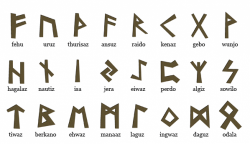Alphabets Page #20
This page lists all the various symbols in the Alphabets category.

An alphabet is a standard set of letters (basic written symbols or graphemes) that is used to write one or more languages based on the general principle that the letters represent phonemes (basic significant sounds) of the spoken language. This is in contrast to other types of writing systems, such as syllabaries (in which each character represents a syllable) and logographies (in which each character represents a word, morpheme, or semantic unit).
Symbols in this category:
Tau
Tau is the 19th letter of the Greek alphabet. In the system of Greek numerals it has a value of 300.
The name in English is pronounced /taʊ/ or /tɔː/,
but in modern Greek it is [taf]. This is because the pronunciation of the combination of Greek letters αυ has changed from ancient to modern times from one of [au] to either [av] or [af], depending on what follows (see Greek orthography).
tāw
Taw, tav, or taf is the twenty-second and last letter of the Semitic abjads, including Phoenician Tāw Phoenician taw.svg, Hebrew Tav ת, Aramaic Taw Taw.svg, Syriac Taw ܬ, and Arabic Tāʼ ت (in abjadi order, 3rd in modern order). Its original sound value is /t/.
Taw
Taw, tav, or taf is the twenty-second and last letter of the Semitic abjads, including Phoenician Tāw Phoenician taw.svg, Hebrew Tav ת, Aramaic Taw Taw.svg, Syriac Taw ܬ, and Arabic Tāʼ ت (in abjadi order, 3rd in modern order). Its original sound value is /t/.
Taw Letter
Taw, tav, or taf is the twenty-second and last letter of the Semitic abjads, including Phoenician Tāw , Hebrew Tav ת, Aramaic Taw , Syriac Taw ܬ, and Arabic ت Tāʼ (22nd in abjadi order, 3rd in modern order). In Arabic, it is also gives rise to the derived letter ث Ṯāʼ. Its original sound value is /t/.
ṭēt
Teth, also written as Ṭēth or Tet, is the ninth letter of the Semitic abjads, including Phoenician Ṭēt Phoenician teth.svg, Hebrew Ṭēt ט, Aramaic Ṭēth Teth.svg, Syriac Ṭēṯ ܛ, and Arabic Ṭāʾ ط. It is 16th in modern Arabic order. The Persian Ța is pronounced as a hard "t" sound and is the 19th letter in the modern Persian alphabet. The Phoenician letter also gave rise to the Greek theta (Θ), originally an aspirated voiceless alveolar stop but now used for the voiceless dental fricative.
The sound value of Teth is /tˤ/, one of the Semitic emphatic consonants.
Ṭēth
Teth, also written as Ṭēth or Tet, is the ninth letter of the Semitic abjads, including Phoenician Ṭēt Phoenician teth.svg, Hebrew Ṭēt ט, Aramaic Ṭēth Teth.svg, Syriac Ṭēṯ ܛ, and Arabic Ṭāʾ ط. It is 16th in modern Arabic order. The Persian Ța is pronounced as a hard "t" sound and is the 19th letter in the modern Persian alphabet. The Phoenician letter also gave rise to the Greek theta (Θ), originally an aspirated voiceless alveolar stop but now used for the voiceless dental fricative.
Teth Letter
In Modern Hebrew, Tet represents a voiceless alveolar plosive /t/, although this can be pharyngealized to produce [tˤ] in traditional Temani and Sephardi pronunciation.
The Phoenix Symbol
In Greek mythology, a phoenix or phenix (Ancient Greek φοίνιξ phóinīx) is a long-lived bird that is cyclically regenerated or reborn. Associated with the sun, a phoenix obtains new life by arising from the ashes of its predecessor. The phoenix was subsequently adopted as a symbol in Early Christianity.
The Ł Letter
Ł or ł, described in English as L with stroke, is a letter of the Polish, Kashubian, Sorbian, Łacinka (Latin Belarusian), Łatynka (Latin Ukrainian), Wymysorys, Navajo, Dene Suline, Inupiaq, Zuni, Hupa, and Dogrib alphabets, several proposed alphabets for the Venetian language, and the ISO 11940 romanization of the Thai alphabet. In Slavic languages, it represents the continuation of Proto-Slavic non-palatal l (see dark L), except Polish where it evolved into /w/. In most non-European languages, it represents a voiceless alveolar lateral fricative or similar sound.
Tsade Letter
Tsade (also spelled Ṣade, Ṣādē, Ṣaddi, Ṣad, Tzadi, Sadhe, Tzaddik) is the eighteenth letter of the Semitic abjads, including Phoenician Ṣādē , Hebrew Ṣādi צ, Aramaic Ṣāḏē , Syriac Ṣāḏē ܨ, Ge'ez Ṣädäy ጸ, and Arabic Ṣād ص. Its oldest sound value is probably /sˤ/, although there is a variety of pronunciation in different modern Semitic languages and their dialects.
Citation
Use the citation below to add this symbols category to your bibliography:
Style:MLAChicagoAPA
"Alphabets Symbols." Symbols.com. STANDS4 LLC, 2024. Web. 21 Dec. 2024. <https://www.symbols.com/category/66/Alphabets>.

















Have a discussion about the Alphabets category with the community:
Report Comment
We're doing our best to make sure our content is useful, accurate and safe.
If by any chance you spot an inappropriate comment while navigating through our website please use this form to let us know, and we'll take care of it shortly.
Attachment
You need to be logged in to favorite.
Log In